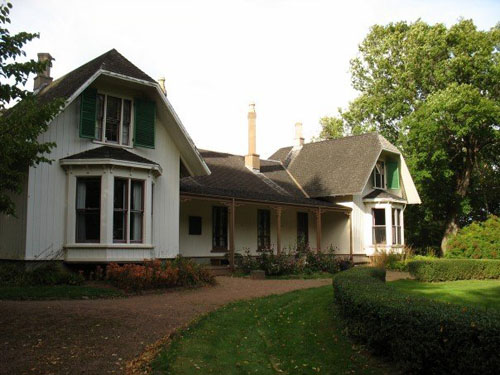Other Name(s)
Ardgowan
Ardgowan
Ardgowan
Ardgowan National Historic Site of Canada
Links and documents
Construction Date(s)
1850/01/01
Listed on the Canadian Register:
2005/03/15
 Statement of Significance
Statement of Significance
Description of Historic Place
Ardgowan National Historic Site is a gracious home from the third quarter of the nineteenth century. Located in Charlottetown, Prince Edward island, it was the home of William Henry Pope, Father of Confederation. The house stands on the two-hectare remains of what was once a much larger estate which today includes the picturesque house, a small barn/ carriage house, and a garden. The designation refers to the historic portion of the house.
Heritage Value
Ardgowan was designated a National Historic Site in 1966
- as the symbolic home of a Father of Confederation in Prince Edward Island.
The heritage value of Ardgowan National Historic Site lies in its association with William Henry Pope at the time of Confederation. This is embodied in the picturesque features of the property reminiscent of that time B the early cottage ornée residence in its garden setting. Ardgowan was the home of William Henry Pope from 1854-1873. The once-substantial estate on the outskirts of Charlottetown is the only surviving residence occupied by an Island Father of Confederation during the Charlottetown Conference. The Popes billetted George Brown and hosted a luncheon for delegates here during the September 1864 conference. While much of the Confederation-era house remains, subsequent owners have added bay windows to the facade as well as making many additions to the rear. Parks Canada acquired Ardgowan in 1967, rehabilitated it in 1980-82 for office use, then added an east wing and single central section in 1994.
Source: Historic Sites and Monuments Board of Canada, Minute, October 1966, November 1977; Commemorative Integrity Statement, February 2001.
Character-Defining Elements
Key elements which contribute to the heritage value of this site include:
- the 1854-1873 portion of the Ardgowan residence on its original footprint (i.e. the front centre block and stepped west wing);
- the domestic scale, and picturesque profile of the original building as indicated by its surviving front centre block and stepped west wing;
- its Gothic Revival detailing (interior and exterior);
- its surviving original exterior materials and craftsmanship (verandah trim, front door and window);
- remaining original layout, materials and features of the interior, particularly in the two major rooms of the west wing and the centre room on the ground floor (the layout, framing, windows, doors, trim, hardware and marbelized slate mantlepieces);
- archaeological remains of the original H-shaped footprint of the house;
- the setting within the open, park-like atmosphere of the gardens surrounding the residence with the sympathetically scaled carriage house.
 Recognition
Recognition
Jurisdiction
Federal
Recognition Authority
Government of Canada
Recognition Statute
Historic Sites and Monuments Act
Recognition Type
National Historic Site of Canada
Recognition Date
1966/10/26
 Historical Information
Historical Information
Significant Date(s)
1854/01/01 to 1873/01/01
Theme - Category and Type
- Governing Canada
- Politics and Political Processes
Function - Category and Type
Current
- Government
- Office or office building
Historic
- Residence
- Single Dwelling
Architect / Designer
n/a
Builder
n/a
 Additional Information
Additional Information
Location of Supporting Documentation
National Historic Sites Directorate, Documentation Centre, 5th Floor, Room 89, 25 Eddy Street, Gatineau, Quebec
Cross-Reference to Collection
Fed/Prov/Terr Identifier
574
Status
Published
Related Places

Ardgowan House
The Ardgowan House is located on a four-acre site in suburban Charlottetown. The wood-frame, H-shaped structure consists of a symmetrical, one-storey, three bay front section with…